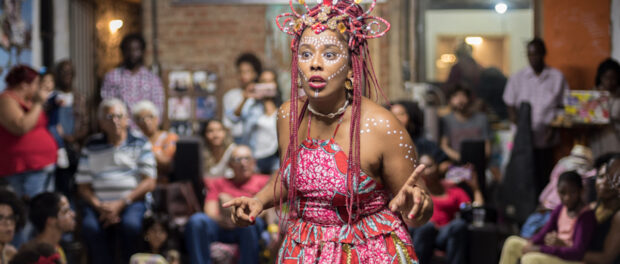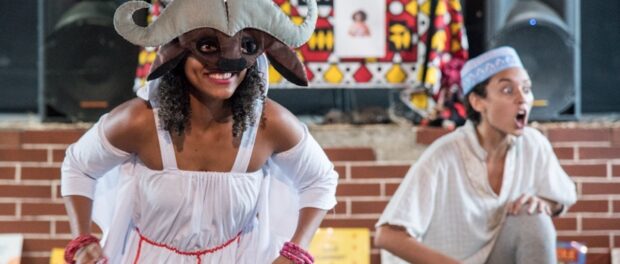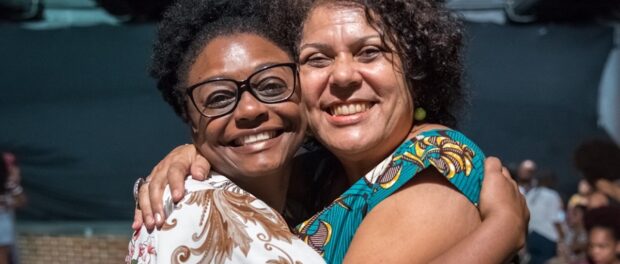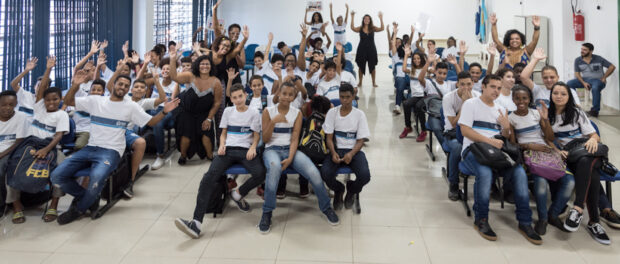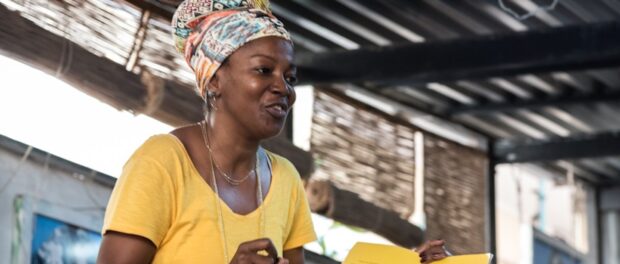
On May 20, a calm day, students in the 14th Black Storytelling course start arriving at the House of Music—a comfortable space in Lapa, Rio de Janeiro—to the sounds of Alabê Ketujazz. The chairs are arranged in a circle with colored cloth in the middle, on top of which lies a small collection of stories featuring “black empowerment”—whether through the illustration, authorship, or plot. Emotions are heightened by the silence and questions arise: Why are we in a circle? Where did she get so many books? What is this music? Why aren’t I familiar with many stories like this?
With this, the first storytelling session kicks off. In a narrative filled with imagery, Sinara Rúbia—who studied Portuguese Literature and works with children’s and young adult literature and storytelling—recounts her trajectory, blending reality with playful elements. She narrates her “encounter” with Mrs. Wisdom, who introduces her to Mr. Knowledge, and at last, Mrs. Intelligence. Thus she begins her adventure with words. No less poetically, but in a more formal tone, the students describe their expectations for the course and their current professions. A web begins to form as the knowledge and experiences of each appear to converge. In general, everyone present—each with their own unique reasons—has the common desire to learn more about their own black identities and about how this knowledge can reach new people and new spaces.
The storytelling course began in 2017 when Rúbia was invited to speak about black stories at Central Única das Favelas (CUFA). Since then, over 200 students have completed the course. Stemming from her own experiences as a black woman, mother, and “artivist” (artist-activist)—as she likes to call herself—the educator saw the necessity of seeking out literary alternatives that are inclusive of black people, beginning in childhood. Her desire solidified after returning from a major literary festival without a single work that respectably represented black culture, making the necessity of a course for educators clear. Thus the course was born, filling an unmet need for educators who believe that a plurality of narratives is the most just educational pathway.
The course consists of 30 hours of class time, divided into six sessions—one introductory day and five days of lessons—that address critical issues for new storytellers. The topics dialogue with one another and each night, students experience wonders and reunions with the Africas from which their ancestors were uprooted.
In the literary process of the course, the first class—on griots—is notably the most important. Guardians of words, wisdom, and myths, griots were the most important figures in their communities in many African cultures. Different from European cultures, which are more grounded in written language, these African peoples considered the knowledge orally transmitted by these guardians to be of the utmost importance. During this lesson, the new storytellers are encouraged to think about who among their friends and family members could be griots—storytellers who brought our cultures here by way of orality, even in subhuman conditions, utilizing the best technology at their disposal: the word of mouth. Despite their enslavement, our ancestors recognized the power of words and storytelling. During this class, the group was overcome by the awakening of consciousness on the importance of telling stories about ourselves to our own. The times have changed but the attempts to silence and render black people invisible continue. Recognizing the power of the words of our forefathers, to the point of breaking free from the shackles of fear and pain so that our traditions would not die, bestowed upon all those present the responsibility of being a storyteller of black history.
With that, we embarked on the second lesson. This gathering subverted strategies of exclusion employed in the images and narratives of the majority of books on the market. The second guest instructor, educator Tatiana Oliveira—who works with formal book editors—perceived the necessity of available and accessible books that place black people and their culture in the first person in an affirmative way. However, selecting these types of books appeared to be a great obstacle; it was as if they did not exist. Oliveira presented to the group of new storytellers the tale behind the fruit of her entrepreneurial and awareness-raising work in creating Nia Literary Productions. The project’s mission is to promote literacy and create young readers, providing access to children’s and young adult literature with African, Afro-Brazilian, and social themes. Oliveira revealed that her work goes beyond sales to a niche market. Nia, which means “purpose,” serves as a means of empowerment, such to prevent Afro-Brazilian culture from getting lost in little-used or racist archives. In this way, the project places on teachers’ and students’ shelves the only weapon that truly generates transformation: education.
Responsibility appears to increase each night—however, with it, comes the urgency of continuing to fight for spaces for speaking and representation. Simone Ricco was the third invited guest. Ricco, a public school teacher, holds a master’s degree in Lusophone African Literature from the Fluminense Federal University (UFF) and is a collaborator in the children’s and young adult literature graduate program at UFF and in the African History and Culture graduate program, a partnership between the Educational Foundation of Duque de Caxias (FEUDUC) and the New Blacks Research Institute (IPN). Her rallying call is: “Let’s increase black representation in academia!” Providing a comprehensive and deep overview, Ricco brings to the circle “black pedagogy“—a method that has been recognized and discussed in academic circles as a means of promoting education rooted in Afro-descendent cultures. During this class, the main takeaway was that even if Law 10.639 (which made the instruction of Afro-Brazilian culture and history mandatory in elementary and middle schools) is repealed, we will not stand down.
On the fourth night, the circle—a highly important shape in African cultures—assumes other forms. The chairs are put away and the body becomes the central theme of this lesson. Paulo Gomes, an actor, cultural producer, and instructor of the Storytelling with Art Workshop was the fourth special guest. At this moment, words become supported by the body and for the first time, stories were chosen and told. This gathering was a special day as the students began to perceive, in practice, the beauty of conveying a message to someone. The stories develop through an empirical and sensorial process, with careful attention paid to the text. Searching for props, the first objects incorporated in the stories are the ones immediately available: cups, keys… everything becomes a part of the scene. Sounds begin in whispers, but the stories adhere to the body. Students’ faces—at first shy and concentrated—become more expressive, softer or more striking. They are immersed in their narratives. Storytellers are born!
On the final day, having already established relationships, the students participate in a creative writing activity. As part of a linguistic exercise, they all receive basic instructions on how to create a story; however, the surprise is that the topic is students’ own lives. They are invited to narrate their own trajectories in a process of self-discovery. The end products of this workshop are filled with emotion and resilience, confirming yet again that the art of storytelling is something inherently human.
The students rehearse their stories for a public presentation—their final assessment during a celebratory gathering. At the end, they are surprised by the dramatization of Alafiá, A Princesa Guerreira (“Alafiá, Warrior Princess”) by Rúbia. The story-turned-book will be launched on June 16 at the Rio Art Museum (MAR). But there’s more. An important aspect of the training program is the Ujima Group, currently composed of 70 people—former students who, after completing their training, participate in storytelling circuits that take black stories to Rio de Janeiro’s public schools.
There have already been three storytelling circuits in honor of the writers Sonia Rosa, Julio Emilio Braz, and most recently, Kiussam de Oliveira (currently underway). The extremely representative works of these authors were told by the Ujima Group to hundreds of students in the Rio de Janeiro public school system enrolled at the following schools: the Mestre Andre Bilingual CIEP in Padre Miguel—200 children; the Dr. Alvaro Alberto Preschool and School in Duque de Caxias—318 children; the Professor Coqueiro Municipal School in Santa Cruz—210 children; the Belgium Municipal School in Guadalupe—150 children; the Vinícius de Moraes CIEP in Jacarezinho—130 children; the Paulo Freire Municipal School in Maré—310 children; and the Conde Pereira Carneiro State School in Irajá—130 youth.
During times of disastrous setbacks in education, work such as that of Sinara Rúbia strengthens our faith in the force of the collectivity and resistance that is so inherent to the Afro-Brazilian people. Undaunting and above all political in nature, the project brings identity, representation, and ancestrality to many educational communities.
In doing so, a clear message is being sent: not one step backward.
Book Launch of Alafiá, A Princesa Guerreira
Date: Sunday, June 16
Location: Rio Museum of Art (MAR)
Time: 2pm
Address: Praça Mauá, 5 – Centro, Rio de Janeiro – RJ
Carla Souza is a teacher by training and loves her job as an early childhood education teacher. Raised in Rocinha, she understands her existence as a black woman and favela resident as a focus of struggle and resistance in the world.

